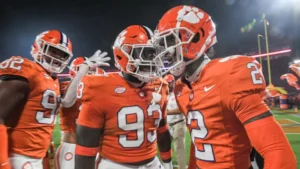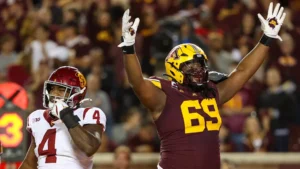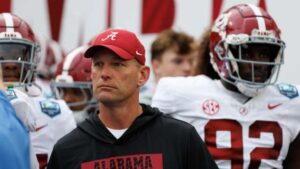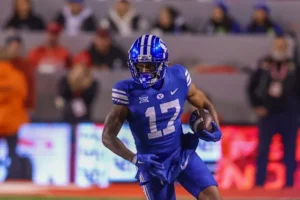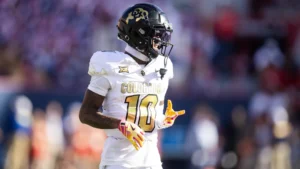
2025 NFL Draft: Examining the Track Record of the Past Ten No. 28 Overall Picks
The NFL Draft is a carefully orchestrated ballet of hope, strategy, and projection. Teams invest countless hours of scouting and analysis in pursuit of selecting the next cornerstone of their franchise. While top-10 picks often dominate headlines and expectations, those selected later in the first round can become foundational players or hidden gems who alter the fortunes of a franchise. One particularly interesting draft slot is No. 28 overall—near the end of the first round, where contenders pick and teams are usually targeting players who can contribute quickly to an already solid roster. As we approach the 2025 NFL Draft, let’s take a deep dive into how the last ten players taken with the 28th overall pick have performed in the league.
Looking back to 2015, the selection at No. 28 has produced a mix of solid contributors, Pro Bowl talents, and a few players who struggled to find their footing in the league. These outcomes highlight the uncertainty that surrounds every draft pick, regardless of how many mock drafts or scouting reports support the selection.
In 2015, the Detroit Lions selected offensive guard Laken Tomlinson out of Duke. Tomlinson didn’t blossom immediately in Detroit and was traded to the San Francisco 49ers in 2017. However, he became a reliable starter and helped anchor the Niners’ offensive line during their run to Super Bowl LIV. Tomlinson eventually earned a Pro Bowl nod in 2021 and cashed in on his success with a contract from the New York Jets in 2022. While he didn’t become a star with the team that drafted him, Tomlinson turned into a dependable starter with a solid NFL career—a win, especially for a pick late in the first round.
The 2016 draft saw the San Francisco 49ers select Joshua Garnett, another interior offensive lineman. Unfortunately, Garnett never panned out. Struggles with injuries and inconsistency plagued his career, and he played in only 22 games over four seasons before retiring from the NFL. Garnett represents the other side of the coin—a player with talent and accolades (Outland Trophy winner in college) whose game didn’t translate to the pros.
In 2017, the Dallas Cowboys picked Michigan defensive end Taco Charlton. With impressive size and college production, Charlton was expected to help boost Dallas’ pass rush. But he failed to deliver. He played just two seasons in Dallas before being released. Though he bounced around the league with stops in Miami, Kansas City, and Pittsburgh, Charlton never developed into the player the Cowboys envisioned. His career serves as a cautionary tale about placing too much emphasis on physical traits without enough consideration for scheme fit and consistency.
The 2018 draft brought a change in fortune for the No. 28 pick. The Pittsburgh Steelers selected safety Terrell Edmunds out of Virginia Tech. While Edmunds never reached a Pro Bowl or All-Pro level, he became a full-time starter almost immediately and provided steady, if unspectacular, play on the back end of Pittsburgh’s defense. He has been durable and dependable—playing in 15 or more games in each of his first five seasons. Though he later joined the Philadelphia Eagles and then the Titans, Edmunds has carved out a respectable career and shown that stability and availability can make a late first-round pick a worthwhile investment.
In 2019, the Los Angeles Chargers selected Jerry Tillery, a defensive tackle from Notre Dame. Tillery entered the league with expectations of being a disruptive force in the interior. Instead, he struggled with consistency and was criticized for a lack of impact, especially against the run. After a few underwhelming seasons in L.A., he was released and picked up by the Las Vegas Raiders. While he’s still active in the league, Tillery hasn’t become a high-level starter, and his selection is often viewed as a miss given the value expected at the tail end of the first round.
A shift toward success resumed in 2020 with the Baltimore Ravens selecting linebacker Patrick Queen from LSU. Queen was immediately plugged into the starting lineup and showed flashes of brilliance as a rookie. His speed and ability to cover ground quickly stood out. While there were ups and downs in coverage and tackling angles during his early seasons, Queen’s development began to trend upward. In 2023, he enjoyed his best season yet and earned his first Pro Bowl selection. He eventually signed with the Pittsburgh Steelers in free agency, a testament to his growing value across the league. Queen may be one of the best examples of a player maximizing his opportunity from the 28th slot.
In 2021, the New Orleans Saints selected defensive end Payton Turner out of Houston. Turner was a high-upside pick with length and athleticism but came with durability concerns. Unfortunately, those concerns proved valid. Injuries severely limited his availability, and he never played a full season during his time with the Saints. Though Turner showed flashes when healthy, he didn’t produce consistently and became a source of frustration for a team that needed defensive line help. As of the 2025 offseason, Turner’s NFL future remains uncertain. He’s an example of the volatility of betting on traits over proven production.
The 2022 draft gave us another mixed case in Devonte Wyatt, a defensive tackle out of Georgia, selected by the Green Bay Packers. Wyatt was part of the national championship-winning Bulldogs and entered the league as a mature, physically ready defender. He took time to adjust during his rookie season, but by Year 2, he began to flash as a disruptive interior presence. While he hasn’t yet ascended into stardom, Wyatt has shown potential to be a key cog in the Packers’ defensive front. The next couple of years will determine whether he becomes a high-impact player or just a steady contributor.
In 2023, the Cincinnati Bengals drafted edge rusher Myles Murphy out of Clemson. A highly touted prospect, Murphy came into the league with size, power, and athleticism. The Bengals eased him into the rotation behind established starters, and while his rookie season didn’t produce eye-popping numbers, he showed steady improvement and strong work ethic. Entering 2025, Murphy is expected to play a bigger role in Cincinnati’s defense. The early returns suggest that patience might pay off with this pick, and Murphy could follow the path of gradual development that leads to long-term success.
And in 2024, the Kansas City Chiefs selected wide receiver Xavier Worthy from Texas. This pick generated buzz, especially after Worthy’s record-breaking 40-yard dash at the NFL Combine. The Chiefs, known for maximizing speed at the receiver position, seemed like an ideal landing spot. In his rookie campaign, Worthy showcased his explosiveness and ability to stretch the field. Though his production was somewhat inconsistent—typical for rookie wideouts—he had several highlight moments and appears poised to become a bigger weapon for Patrick Mahomes moving forward. Worthy represents the modern NFL’s love affair with speed and the potential for an explosive payoff.
What we see from this decade-long sample is a portrait of unpredictability. Of the ten players selected at No. 28 overall from 2015 to 2024, only a few have emerged as true difference-makers. Patrick Queen stands out as a Pro Bowler. Laken Tomlinson and Terrell Edmunds have had long, stable careers with meaningful contributions, even if they didn’t become stars. Players like Joshua Garnett, Taco Charlton, and Payton Turner struggled to meet expectations due to injuries, inconsistency, or fit. Others, like Devonte Wyatt and Myles Murphy, are still works in progress and could shift the narrative further depending on their performance in upcoming seasons.
For teams picking near the end of the first round, the lesson is clear: the No. 28 pick can yield talent, but the margin for error is slim. These teams are usually playoff contenders, meaning they often need immediate help rather than long-term projects. However, betting on upside isn’t inherently wrong—it just requires strong development systems and patience. In contrast, players with high floors but limited ceilings can provide stability, though they may not move the needle as much.
As the 2025 NFL Draft approaches, whoever hears their name called at No. 28 will step into a unique lineage. There’s no guarantee of stardom or longevity, but the opportunity is real. With the right fit, coaching, and work ethic, that player could become the next Patrick Queen—or even a franchise cornerstone. The path may be narrow, but history shows it’s there for the taking.

